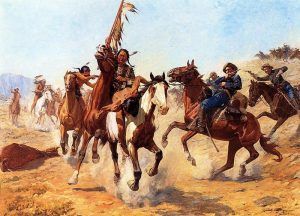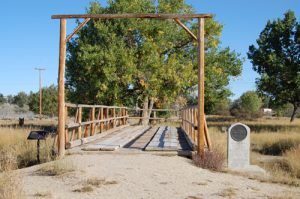The predecessor of Fort Caspar, Wyoming, was Platte Bridge Station, established in 1858 as one of a series of fortified stations on the Oregon-California Trail. Located on the south side of the North Platte River at a crossing point and emigrant campground, the Platte Bridge post protected wagon trains, mail stages, and the supply-communication lines of the Mormon Expedition to Utah (1857-58).
Adjacent to the fort, at a place known as Mormon Ferry, emigrants crossed the river by ferry, operated by some Mormons in 1847-50 and after that by a private company. Regular troops abandoned the station in 1859, the same year a 1,000-foot toll bridge was completed across the river. This bridge supplemented one a few miles to the east, built in 1853.
In 1862, during the Civil War, Volunteers reoccupied Platte Bridge Station to counter increased Indian hostilities along the Oregon-California Trail and guard the telegraph lines. The Indian threat peaked in 1865, when some 2,500-3,000 Sioux, Cheyenne, and Arapaho descended on the trail from the Powder River country.
Together they planned a major attack against the Platte Bridge Station, commanded by Major Martin Anderson of the 11th. Kansas Cavalry. The garrison consisted of about 120 men of the Kansas Cavalry, detachments of Ohio Cavalry, and some volunteers under Captain A Smith Lybe.
In the meantime, an eastward-bound Army wagon train, loaded with supplies and guarded by Sergeant Amos J. Custard and 25 men, was going to the Platte Bridge Station. Having spied numerous Indians north of the North Platte River, Major Martin Anderson, in command of Platte Bridge Station, saw the threat to the wagon train and ordered Lieutenant Caspar W. Collins, Sergeants Adolph Hankhammer, and Isaac Pennock, and Corporal Henry Grimm to lead 25 troops and escort the wagon train to the post. Knowing that the odds were very much against them, Collins fully expected to die, and before he left, he said to a friend, “Jim, I know I shall never get back alive. Here is my cap that you have admired so much. Keep it to remember me by.”
At 7:30 a.m. on July 26, 1865, Collins and his men crossed the long wooden bridge across the Platte River and turned west. Riding along the river banks near the bluffs, they were ambushed by about 1,000 warriors. The troops managed to fight their way back to the bridge, but Collins and four soldiers lost their lives, and eight more were wounded.
Later that morning, Major Martin Anderson sent Lieutenant George M. Walker and 15 men out to repair a telegraph line that the Indians had cut in their raid about two miles east of the station. Captain Lybe and several troops followed them, protecting their rear. Walker had barely reached the broken line when Lybe signaled that Indians were coming. The soldiers quickly fell back as the Indians closed in. Battling their way back, the howitzer at the station held the Indians long enough for many of the soldiers to retreat behind its walls. However, six soldiers were killed and nine wounded. Estimated Indian losses were five killed and ten wounded.
Through an error, the Army renamed Platte Bridge Station to Fort Casper, the spelling adopted by the city that grew up adjacent to it. Troops enlarged and rebuilt the fort in 1866, but the following year evacuated it and moved to Fort Fetterman, Wyoming. Almost immediately, the Indians burned the buildings and the bridge.
A replica of Fort Casper (now spelled Fort Caspar) at the southwestern edge of Casper marks the site of the original log fort. Constructed in the 1930s by the Works Progress Administration, it is owned by the city and administered by the Fort Caspar Commission.
© Kathy Alexander/Legends of America, updated April 2022.
Also See:
Indian War Campaigns and Battles



